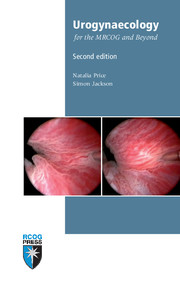Book contents
- Frontmatter
- Contents
- Preface
- Abbreviations
- 1 Applied anatomy and physiology of the lower urinary tract
- 2 Definition and prevalence of urinary incontinence
- 3 Initial assessment of lower urinary tract symptoms
- 4 Further investigation of lower urinary tract symptoms
- 5 Management of stress urinary incontinence
- 6 Management of overactive bladder syndrome
- 7 Recurrent urinary tract infection
- 8 Haematuria
- 9 Painful bladder syndrome and interstitial cystitis
- 10 Pregnancy and the renal tract
- 11 Ageing and urogenital symptoms
- 12 Fistulae and urinary tract injuries
- 13 Pelvic organ prolapse
- 14 Colorectal disorders
- 15 Obstetric anal sphincter injuries
- Index
3 - Initial assessment of lower urinary tract symptoms
Published online by Cambridge University Press: 05 July 2014
- Frontmatter
- Contents
- Preface
- Abbreviations
- 1 Applied anatomy and physiology of the lower urinary tract
- 2 Definition and prevalence of urinary incontinence
- 3 Initial assessment of lower urinary tract symptoms
- 4 Further investigation of lower urinary tract symptoms
- 5 Management of stress urinary incontinence
- 6 Management of overactive bladder syndrome
- 7 Recurrent urinary tract infection
- 8 Haematuria
- 9 Painful bladder syndrome and interstitial cystitis
- 10 Pregnancy and the renal tract
- 11 Ageing and urogenital symptoms
- 12 Fistulae and urinary tract injuries
- 13 Pelvic organ prolapse
- 14 Colorectal disorders
- 15 Obstetric anal sphincter injuries
- Index
Summary
All women with lower urinary tract symptoms must have a basic assessment that should include a clinical history and examination, urinalysis and a self-completed urinary diary. All of this can be performed within the primary care setting. Many women will be treatable at this stage.
History
The onset of urinary symptoms and their duration and severity should be recorded. Patients usually present with a number of symptoms; it is important that the most troublesome one is identified, along with any that may indicate serious underlying pathology (for example, haematuria).
A good clinical history will establish how symptoms affect aspects of daily life and social, personal and sexual relationships. A symptom that may not bother one person can have a devastating impact on another; for example, mild urinary stress incontinence may not trouble those with an inactive lifestyle while severely incapacitating a gymnast. A woman with frequency and urgency may cope well if her office desk is close to a toilet while debilitating a teacher who has to lecture for an hour without interruption.
Common lower urinary tract symptoms are listed in the box on pages 10–11.
OTHER SYMPTOMS
Global pelvic dysfunction is commonly present and, in addition to the above, the clinician should enquire about colorectal symptoms and genitourinary prolapse (anal incontinence is still a taboo subject and may not be volunteered).
- Type
- Chapter
- Information
- Urogynaecology for the MRCOG and Beyond , pp. 9 - 16Publisher: Cambridge University PressPrint publication year: 2012

